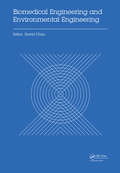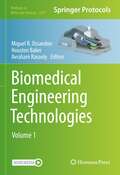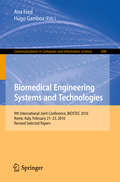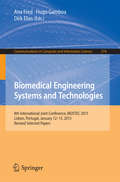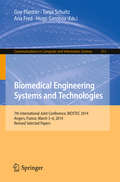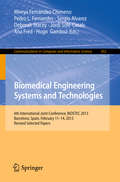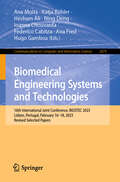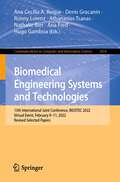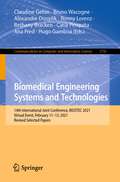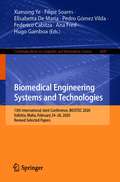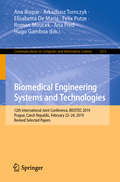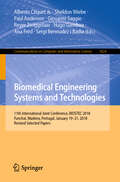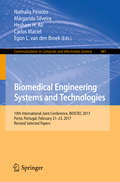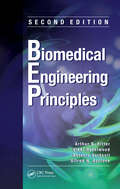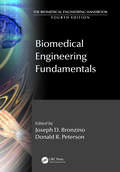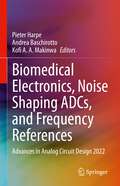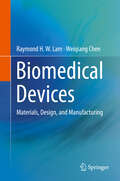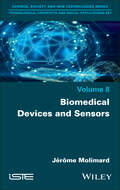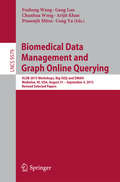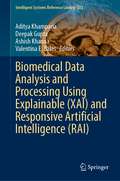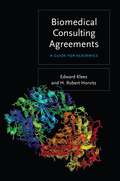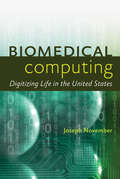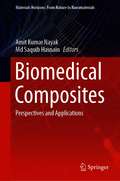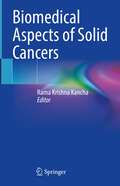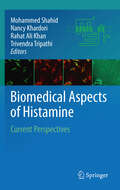- Table View
- List View
Biomedical Engineering and Environmental Engineering: Proceedings of the 2014 2nd International Conference on Biomedical Engineering and Environmental Engineering (ICBEEE 2014), December 24-25, 2014, Wuhan, China
by David ChanThis conference series is a forum for enhancing mutual understanding between Biomedical Engineering and Environmental Engineering field. This proceeding provides contributions from many experts representing industry and academic establishments worldwide. The researchers are from different countries and professional. The conference brought 
Biomedical Engineering Technologies: Volume 1 (Methods in Molecular Biology #2393)
by Avraham Rasooly Houston Baker Miguel R. OssandonThis volume provides detailed technical protocols on current biosensors and imaging technologies and Chapters focus on optical, electrochemical, Quartz crystal microbalance (QCM) biosensors and on medical imaging technologies such as tomography, MRI, and NMR. Written in the format of the highly successful Methods in Molecular Biology series, each chapter includes an introduction to the topic, lists necessary materials and reagents, includes tips on troubleshooting and known pitfalls, and step-by-step, readily reproducible protocols. Authoritative and practical, Biomedical Engineering Technologies, Volume 1 provides technical details in descriptions of major technologies by experts in the field.
Biomedical Engineering Systems and Technologies: 9th International Joint Conference, BIOSTEC 2016, Rome, Italy, February 21–23, 2016, Revised Selected Papers (Communications in Computer and Information Science #690)
by Ana Fred Hugo GamboaThis book contains the best papers of the First International Joint Conference on B- medical Engineering Systems and Technologies (BIOSTEC 2008), organized by the Institute for Systems and Technologies of Information Control and Communication (INSTICC), technically co-sponsored by the IEEE Engineering in Medicine and Bi- ogy Society (EMB), ACM SIGART and the Workflow Management Coalition (WfMC), in cooperation with AAAI. The purpose of the International Joint Conference on Biomedical Engineering S- tems and Technologies is to bring together researchers and practitioners, including engineers, biologists, health professionals and informatics/computer scientists, int- ested in both theoretical advances and applications of information systems, artificial intelligence, signal processing, electronics and other engineering tools in knowledge areas related to biology and medicine. BIOSTEC is composed of three co-located conferences; each specializes in one of the aforementioned main knowledge areas, namely: * BIODEVICES (International Conference on Biomedical Electronics and - vices) focuses on aspects related to electronics and mechanical engineering, - pecially equipment and materials inspired from biological systems and/or - dressing biological requirements. Monitoring devices, instrumentation sensors and systems, biorobotics, micro-nanotechnologies and biomaterials are some of the technologies addressed at this conference.
Biomedical Engineering Systems and Technologies: 8th International Joint Conference, BIOSTEC 2015, Lisbon, Portugal, January 12-15, 2015, Revised Selected Papers (Communications in Computer and Information Science #574)
by Ana Fred Hugo Gamboa Dirk EliasThis book constitutes the thoroughly refereedpost-conference proceedings of the 8th International Joint Conference onBiomedical Engineering Systems and Technologies, BIOSTEC 2015, held in Lisbon,Portugal, in January 2015. The 27 revised full papers presented together with aninvited paper were carefully reviewed and selected from a total of 375submissions. The papers cover a wide range of topics and are organized in fourgeneral topical sections on biomedical electronics and devices;bioimaging; bioinformatics models,methods and algorithms; bio-inspired systems and signalprocessing; health informatics.
Biomedical Engineering Systems and Technologies: 7th International Joint Conference, BIOSTEC 2014, Angers, France, March 3-6, 2014, Revised Selected Papers (Communications in Computer and Information Science #511)
by Ana Fred Hugo Gamboa Guy Plantier Tanja SchultzThis book constitutes the thoroughly refereed post-conference proceedings of the 7th International Joint Conference on Biomedical Engineering Systems and Technologies, BIOSTEC 2014, held in Angers, France, in March 2014. The 25 revised full papers presented were carefully reviewed and selected from a total of 362 submissions. The papers cover a wide range of topics and are organized in topical sections on biomedical electronics and devices; bioimaging; bioinformatics models, methods and algorithms; bio-inspired systems and signal processing; health informatics.
Biomedical Engineering Systems and Technologies: 6th International Joint Conference, BIOSTEC 2013, Barcelona, Spain, February 11-14, 2013, Revised Selected Papers (Communications in Computer and Information Science #452)
by Jordi Solé-Casals Ana Fred Mireya Fernández-Chimeno Pedro L. Fernandes Sergio Alvarez Deborah Stacey Hugo GamboaThis book constitutes the thoroughly refereed post-conference proceedings of the 6th International Joint Conference on Biomedical Engineering Systems and Technologies, BIOSTEC 2013, held in Barcelona, Spain, in February 2013. The 28 revised full papers presented were carefully reviewed and selected from a total of 392 submissions. The papers cover a wide range of topics and are organized in four general topical sections on biomedical electronics and devices; bioinformatics models, methods and algorithms; bio-inspired systems and signal processing; health informatics.
Biomedical Engineering Systems and Technologies: 16th International Joint Conference, BIOSTEC 2023, Lisbon, Portugal, February 16–18, 2023, Revised Selected Papers (Communications in Computer and Information Science #2079)
by Ana Fred Hugo Gamboa Hesham Ali Ioanna Chouvarda Federico Cabitza Katja Bühler Ana Moita Ning DengThis book constitutes the refereed post-conference proceedings of the 16th International Joint Conference on Biomedical Engineering Systems and Technologies, BIOSTEC 2023, held in Lisbon, Portugal, during February 16-18, 2023. The 7 regular papers included in this book were carefully reviewed and selected from 246 submissions. They contribute to the understanding of relevant trends of current research on Biomedical Engineering Systems and Technologies, that include Pattern Recognition and Machine Learning, Decision Support Systems, Data Mining and Data Analysis, eHealth Applications, eHealth, Detection and Identification, Computational Intelligence, Cognitive Informatics, Big Data in Healthcare and Assistive Technologies.
Biomedical Engineering Systems and Technologies: 15th International Joint Conference, BIOSTEC 2022, Virtual Event, February 9–11, 2022, Revised Selected Papers (Communications in Computer and Information Science #1814)
by Ana Fred Hugo Gamboa Ronny Lorenz Athanasios Tsanas Ana Cecília A. Roque Denis Gracanin Nathalie BierThis book constitutes the refereed post-proceedings of the 15th International Conference on Biomedical Engineering Systems and Technologies, BIOSTEC 2022, held as a Virtual Event, during February 9–11, 2022. The 21 full papers included in this book were carefully reviewed and selected from 262 submissions. The papers selected to be included in this book contribute to the understanding of relevant trends of current research on Biomedical Engineering Systems and Technologies, including: Pattern Recognition and Machine Learning, Application of Health Informatics in Clinical Cases, Evaluation and Use of Healthcare IT, Medical Signal Acquisition, Analysis and Processing, Data Mining and Data Analysis, Decision Support Systems, e-Health, e-Health Applications, Mobile Technologies for Healthcare Applications and Medical Devices design.
Biomedical Engineering Systems and Technologies: 14th International Joint Conference, BIOSTEC 2021, Virtual Event, February 11–13, 2021, Revised Selected Papers (Communications in Computer and Information Science #1710)
by Ana Fred Hugo Gamboa Claudine Gehin Bruno Wacogne Alexandre Douplik Ronny Lorenz Bethany Bracken Cátia PesquitaThis book constitutes the refereed proceedings of the 14th International Joint Conference on Biomedical Engineering Systems and Technologies, BIOSTEC 2021, held virtually due to the COVID-19 crisis, in February 2021. The conference was held virtually due to the COVID-19 crisis.The 13 full papers included in this book were carefully reviewed and selected from 265 submissions. The papers selected to be included in this book contribute to the understanding of relevant trends of current research on Biomedical Engineering Systems and Technologies, including: Pattern Recognition and Machine Learning, Application of Health Informatics in Clinical Cases, Evaluation and Use of Healthcare IT, Medical Signal Acquisition, Analysis and Processing, Data Mining and Data Analysis, Decision Support Systems, e-Health, e-Health Applications, Mobile Technologies for Healthcare Applications and Medical Devices design.
Biomedical Engineering Systems and Technologies: 13th International Joint Conference, BIOSTEC 2020, Valletta, Malta, February 24–26, 2020, Revised Selected Papers (Communications in Computer and Information Science #1400)
by Ana Fred Hugo Gamboa Federico Cabitza Elisabetta De Maria Xuesong Ye Filipe Soares Pedro Gómez VildaThis book constitutes extended and revised versions of the selected papers from the 13th International Joint Conference on Biomedical Engineering Systems and Technologies, BIOSTEC 2020, held in Valletta, Malta, in February 2020.The 29 revised and extended full papers presented were carefully reviewed and selected from a total of 363 submissions. The papers are organized in topical sections on biomedical electronics and devices; bioimaging; bioinformatics models, methods and algorithms; bio-inspired systems and signal processing; health informatic
Biomedical Engineering Systems and Technologies: 12th International Joint Conference, BIOSTEC 2019, Prague, Czech Republic, February 22–24, 2019, Revised Selected Papers (Communications in Computer and Information Science #1211)
by Ana Fred Hugo Gamboa Ana Roque Arkadiusz Tomczyk Elisabetta De Maria Felix Putze Roman MoucekThis book constitutes the thoroughly refereed post-conference proceedings of the 12th International Joint Conference on Biomedical Engineering Systems and Technologies, BIOSTEC 2019, held in Prague, Czech Republic, in February 2019.The 22 revised and extended full papers presented were carefully reviewed and selected from a total of 271 submissions. The papers are organized in topical sections on biomedical electronics and devices; bioimaging; bioinformatics models, methods and algorithms; bio-inspired systems and signal processing health informatics.
Biomedical Engineering Systems and Technologies: 11th International Joint Conference, BIOSTEC 2018, Funchal, Madeira, Portugal, January 19–21, 2018, Revised Selected Papers (Communications in Computer and Information Science #1024)
by Paul Anderson Reyer Zwiggelaar Ana Fred Hugo Gamboa Giovanni Saggio Alberto Cliquet Jr. Sheldon Wiebe Sergi Bermúdez i BadiaThis book constitutes the thoroughly refereed post-conference proceedings of the 11th International Joint Conference on Biomedical Engineering Systems and Technologies, BIOSTEC 2018, held in Funchal, Madeira, Portugal, in January 2018.The 25 revised full papers presented were carefully reviewed and selected from a total of 299 submissions. The papers are organized in topical sections on biomedical electronics and devices; bioimaging; bioinformatics models, methods and algorithms; health informatics.
Biomedical Engineering Systems and Technologies: 10th International Joint Conference, Biostec 2017, Porto, Portugal, February 21-23, 2017, Revised Selected Papers (Communications In Computer And Information Science #881)
by Nathalia Peixoto Margarida Silveira Hesham H. Ali Carlos Maciel Egon L. van den BroekThis book constitutes the thoroughly refereed post-conference proceedings of the 10th International Joint Conference on Biomedical Engineering Systems and Technologies, BIOSTEC 2017, held in Porto, Portugal, in February 2017.The 20 revised full papers presented were carefully reviewed and selected from a total of 297 submissions. The papers are organized in topical sections on biomedical electronics and devices; bioimaging; bioinformatics models, methods and algorithms; bio-inspired systems and signal processing; and health informatics.
Biomedical Engineering Principles
by Arthur B. Ritter Vikki Hazelwood Antonio Valdevit Alfred N. AscioneCurrent demand in biomedical sciences emphasizes the understanding of basic mechanisms and problem solving rather than rigid empiricism and factual recall. Knowledge of the basic laws of mass and momentum transport as well as model development and validation, biomedical signal processing, biomechanics, and capstone design have indispensable roles i
Biomedical Engineering Fundamentals (The Biomedical Engineering Handbook, Fourth Edition)
by Joseph D. Bronzino Donald R. PetersonKnown as the bible of biomedical engineering, The Biomedical Engineering Handbook, Fourth Edition, sets the standard against which all other references of this nature are measured. As such, it has served as a major resource for both skilled professionals and novices to biomedical engineering.Biomedical Engineering Fundamentals, the first volume of
Biomedical Electronics, Noise Shaping ADCs, and Frequency References: Advances in Analog Circuit Design 2022
by Kofi A. A. Makinwa Andrea Baschirotto Pieter HarpeThis book is based on the 18 tutorials presented during the 30th workshop on Advances in Analog Circuit Design. Expert designers present readers with information about a variety of topics at the frontier of analog circuit design, with specific contributions focusing on analog circuits for machine learning, current/voltage/temperature sensors, and high-speed communication via wireless, wireline, or optical links. This book serves as a valuable reference to the state-of-the-art, for anyone involved in analog circuit research and development.
Biomedical Devices: Materials, Design, and Manufacturing
by Weiqiang Chen Raymond H. LamThis textbook provides essential knowledge for biomedical product development, including material properties, fabrication processes and design techniques for different applications, as well as process design and optimization. This book is multidisciplinary and readers can learn techniques to apply acquired knowledge for various applications of biomedical design. Further, this book encourages readers to discover and convert newly reported technologies into products and services for the future development of biomedical applications. This is an ideal book for upper-level undergraduate and graduate students, engineers, technologists, and researchers working in the area of biomedical engineering and manufacturing.This book also:Provides a comprehensive set of fundamental knowledge for engineering students and entry level engineers to design biomedical devicesOffers a unique approach to manufacturing of biomedical devices by integrating and formulating different considerations in process design tasks into optimization problemsProvides a broad range of application examples to guide readers through the thinking process of designing and manufacturing biomedical devices, from basic understanding about the requirements and regulations to a set of manufacturing parameters
Biomedical Devices and Sensors
by Jérôme MolimardMonitoring the human body is a key element of digital health science. Low-cost sensors derived from smartphones or smartwatches may give the impression that sensors are readily available; however, to date, very few of them are actually medical devices. Designing medical devices requires us to undertake a specific approach demanding special skills, as it concerns the integrity of the human body. The process is tightly framed by state regulations in order to ensure compliance with quality assessment, risk management and medical ethics requirements. This book aims to give biomedical students an overview on medical devices design. It firstly gives a historical and economical approach, then develops key elements in medical device design with reference to EU and US regulations, and finally describes sensors for the human body. The clinical approach is presented as the central element in medical device qualification and this offers a perspective on the use of numerical simulation, particularly since its continued growth in the USA; despite the fact that the approach is strictly limited by regulations.
Biomedical Data Management and Graph Online Querying: VLDB 2015 Workshops, Big-O(Q) and DMAH, Waikoloa, HI, USA, August 31 – September 4, 2015, Revised Selected Papers (Lecture Notes in Computer Science #9579)
by Fusheng Wang Gang Luo Chunhua Weng Arijit Khan Prasenjit Mitra Cong YuThis book constitutes the refereed proceedings of the two International Workshops on Big-Graphs Online Querying, Big-O(Q) 2015, and Data Management and Analytics for Medicine and Healthcare, DMAH 2015, held at Waikoloa, Hawaii, USA on August 31 and September 4, 2015, in conjunction with the 41st International Conference on Very Large Data Bases, VLDB 2015. The 9 revised full papers presented together with 5 invited papers and 1 extended abstract were carefully reviewed and selected from 22 initial submissions. The papers are organized in topical sections on information retrieval and data analytics for electronic medical records; data management and visualization of medical data; biomedical data sharing and integration; medical imaging analytics; and big-graphs online querying.
Biomedical Data Analysis and Processing Using Explainable (Intelligent Systems Reference Library #222)
by Valentina E. Balas Deepak Gupta Ashish Khanna Aditya KhampariaThe book discusses Explainable (XAI) and Responsive Artificial Intelligence (RAI) for biomedical and healthcare applications. It will discuss the advantages in dealing with big and complex data by using explainable AI concepts in the field of biomedical sciences. The book explains both positive as well as negative findings obtained by explainable AI techniques. It features real time experiences by physicians and medical staff for applied deep learning based solutions. The book will be extremely useful for researchers and practitioners in advancing their studies.
Biomedical Consulting Agreements
by Edward Klees H. Robert HorvitzThere can be a clash of cultures when academic scientists negotiate consulting agreements with biotechnology or pharmaceutical companies. Scientists, accustomed to the collegial atmosphere of the laboratory and sometimes disdainful of legal paperwork, might be less than diligent in reading the fine print. On the other hand, a company--motivated to protect discoveries and trade secrets--might write provisions that are favorable to its interests, leaving it to the scientist to raise objections or offer a counterproposal. The scientist, meanwhile, might believe that it would be impolite or antagonistic to raise questions about a company's agreement. This book offers an essential guide for academic scientists and physicians who are considering consulting work in the field of biomedicine. In it, the authors--an attorney and a Nobel Laureate in Medicine, both with extensive experience reviewing and negotiating consulting agreements--outline key issues to consider before signing a consulting agreement. These issues range from the obvious--intellectual property, confidentiality, and fees--to those that might not spring immediately to mind, including indemnity, different classes of stock, and the relevance of insider trading and securities laws.
Biomedical Computing: Digitizing Life in the United States (The Johns Hopkins University Studies in Historical and Political Science #130)
by Joseph A. NovemberWinner of the Computer History Museum Prize of the Special Interest Group: Computers, Information, and SocietyImagine biology and medicine today without computers. What would laboratory work be like if electronic databases and statistical software did not exist? Would disciplines like genomics even be feasible if we lacked the means to manage and manipulate huge volumes of digital data? How would patients fare in a world absent CT scans, programmable pacemakers, and computerized medical records?Today, computers are a critical component of almost all research in biology and medicine. Yet, just fifty years ago, the study of life was by far the least digitized field of science, its living subject matter thought too complex and dynamic to be meaningfully analyzed by logic-driven computers. In this long-overdue study, historian Joseph November explores the early attempts, in the 1950s and 1960s, to computerize biomedical research in the United States.Computers and biomedical research are now so intimately connected that it is difficult to imagine when such critical work was offline. Biomedical Computing transports readers back to such a time and investigates how computers first appeared in the research lab and doctor's office. November examines the conditions that made possible the computerization of biology—including strong technological, institutional, and political support from the National Institutes of Health—and shows not only how digital technology transformed the life sciences but also how the intersection of the two led to important developments in computer architecture and software design. The history of this phenomenon has been only vaguely understood. November's thoroughly researched and lively study makes clear for readers the motives behind computerizing the study of life and how that technology profoundly affects biomedical research today.
Biomedical Composites: Perspectives and Applications (Materials Horizons: From Nature to Nanomaterials)
by Amit Kumar Nayak Md Saquib HasnainThis book provides an overview of biocomposite chemistry, chemical modifications, characterization and applications in biomedicine, with emphasis on recent advances in the field. Authored by experts, the chapters discuss the design, development and selection of biomedical composites for a particular therapeutic application, as well as providing insight into the regulatory and clinical aspects of biomedical composite use. While this book is primarily intended for scientists from the fields of medical, pharmaceutical, biotechnological and biomedical engineering, it is also useful as an advanced text for students and research scholars.
Biomedical Aspects of Solid Cancers
by Rama Krishna KanchaThis book offers an overview of the biological basis of 26 different solid cancers for scientists and oncologists to understand the clinical challenges. The book provides a quick, simplified, and updated review of the present genetic or genomic medicine era. With genetic and molecular details to enhance understanding of biological mechanisms underlying disease pathogenesis and treatment response, each chapter covers epidemiology, risk factors, classification, pathophysiology, genetics, and treatment of solid cancers.This book is a beginner’s guide for life sciences and medicine graduate students, fellows in training, biomedical sciences researchers, principal investigators, clinician-researchers and oncologists.
Biomedical Aspects of Histamine: Current Perspectives
by Nancy Khardori Mohammed Shahid Rahat Ali Khan Trivendra TripathiSince its identification by Sir Henry H. Dale a century ago, histamine has become one of the most important multifunctional biogenic amines in the field of biomedicine. The pharmacological effects of histamine are mediated through four types of membrane histamine receptors; H1R, H2R, H3R and H4R, which are all heptahelical G-protein-coupled receptors. It has been known to play the broadest spectrum of activities in various physiological and pathological conditions including cell proliferation, differentiation, hematopoiesis, embryonic development, regeneration, wound healing, aminergic neurotransmission and numerous brain functions, secretion of pituitary hormones, regulation of gastrointestinal and circulatory functions, cardiovascular system, as well as inflammatory reactions, modulation of the immune response, endocrine function and homeostasis, and other important areas. This book is a compendium of the current state of established and investigational literature on Histamine, its receptors and their Agonists and antagonists. It provides a comprehensive overview of histamine biology in the field of biochemistry, cell biology, molecular biology, immunology, allergy, neurobiology, pharmacology, microbiology and reproductive biology. The first section on Histamine biology and physiology leads into subsequent sections on enzymology, pharmacology, regulation of the immune system and cell proliferation and role in allergic and other diseases including acid peptic diseases, inflammatory diseases, autoimmune and cancer diseases, nervous system, reproductive functions and hematopoiesis. The compilation of chapters in the book presents the most recent advances in histamine research and bridges the basic and clinical aspects of histamine biology.
